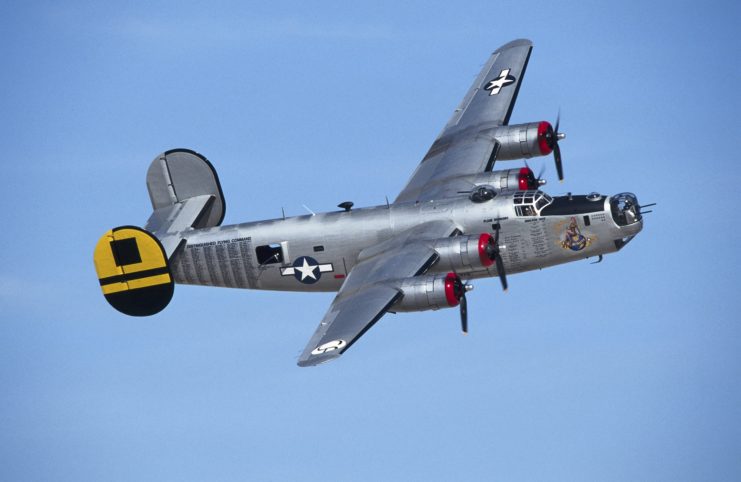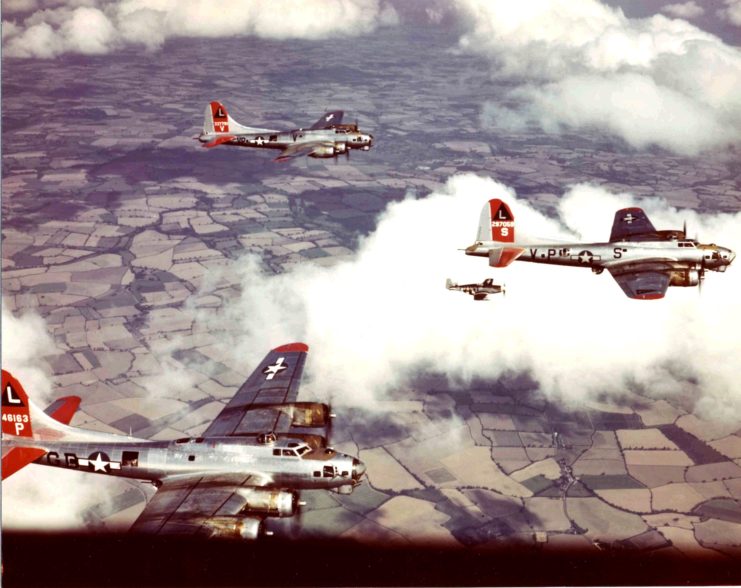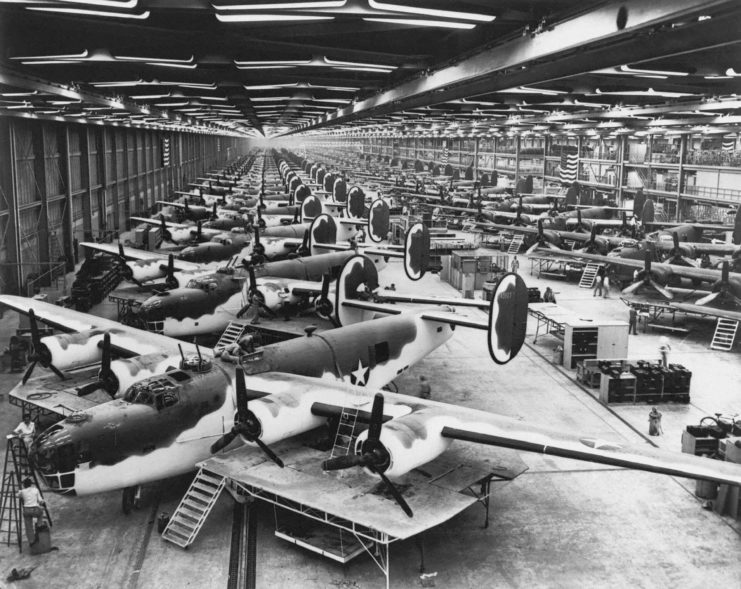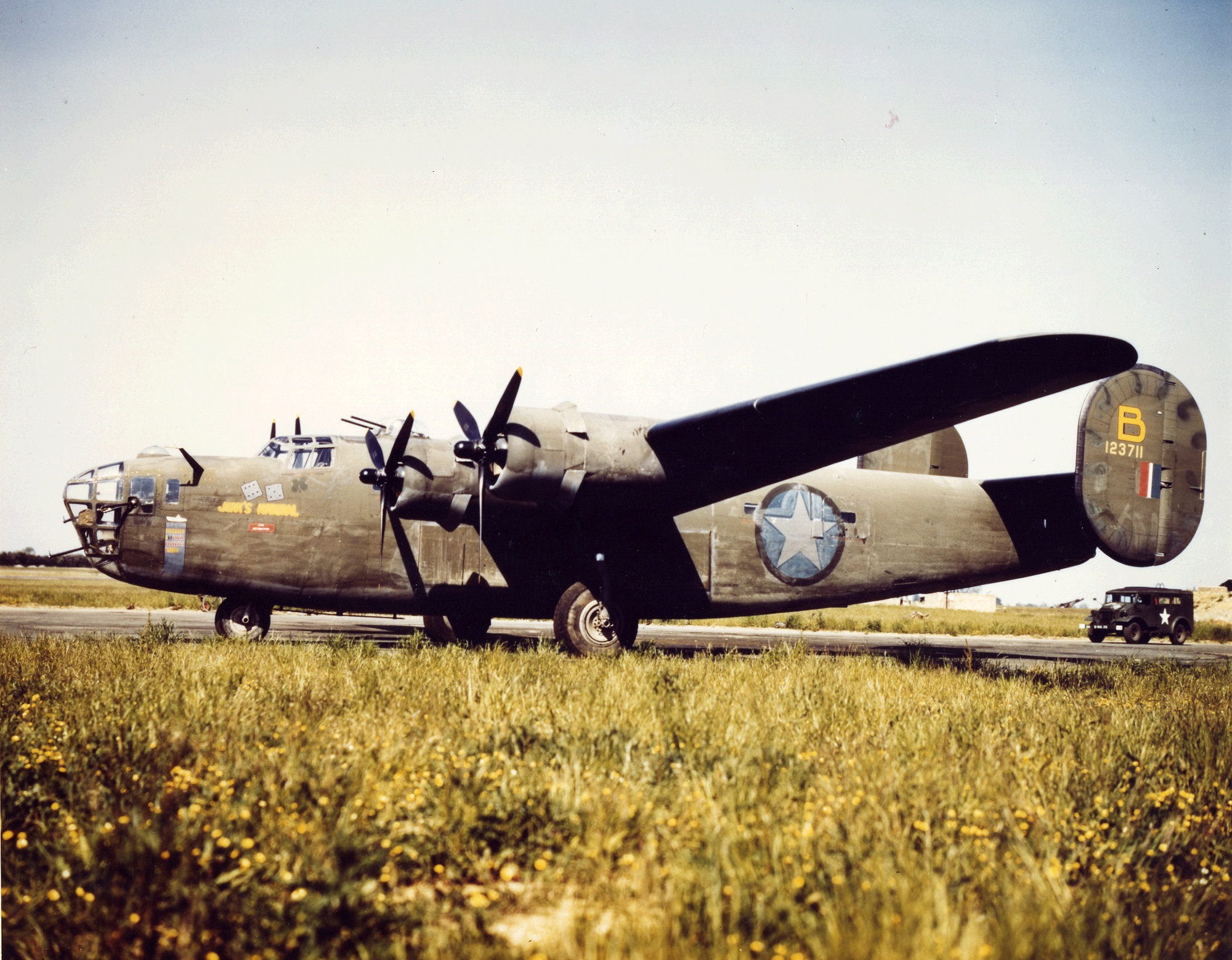The B-24 Liberator was one of the US’ primary heavy bombers of WWII. It fought alongside the legendary B-17 but has since been overshadowed by the sleeker and more popular Flying Fortress. Despite this, the B-24 was able to carry a heavier bomb load than its Boeing counterpart, and also had a higher top speed and cruise speed. Over 18,000 B-24s were built during WWII, making it not only the most produced American military aircraft but the most produced bomber in history.
The B-24’s design

It is fitting that the B-24 and B-17 served so closely alongside each other during the war, as their development was equally linked.
In 1938 the United States Army Air Corps approached Consolidated and asked the company to build the B-17 Flying Fortress under licensed production. After reviewing the aircraft, Consolidated believed they could design and build a more capable bomber.
Consolidated set to work designing this new aircraft, which was then known as the Model 32. Using the latest aerodynamic practices, the bomber would employ the distinct ‘Davis Wing’, which was particularly great at lower speeds. The wing was highly efficient at speeds associated with bombers at the time while maintaining a thick profile that allowed for extra fuel storage.
The B-24 used two vertical stabilizers at the rear and featured two bomb bays. Reducing aerodynamic drag was one of Consolidated’s main goals with the B-24. The B-24’s bomb bay doors retracted into the fuselage when open, rather than unfold into the oncoming air like rivals.
This smart design greatly reduced drag while the bomb bays were open, and made access easier while on the ground. The aircraft was the first American bomber to use tricycle landing gear, which helps to improve runway visibility while taxiing, compared to taildraggers.
In terms of armament, the B-24 was similar to the B-17. At the time of its inception, the Allies did not yet possess a fighter aircraft capable of escorting bombers deep into Europe and back, so bombers had to provide protection for themselves. For the B-24, this came in the form of 10 .50 caliber machine guns mounted in positions in the tail, waist, belly, and on top of the fuselage.
The belly was protected by a Sperry ball turret. Unlike the B-17, the B-24’s ball turret was retractable as the aircraft had minimal ground clearance. This gave the B-24 the ability to further reduce drag by raising the turret into the fuselage in-flight.
In the B-17s shadow

Although on paper the B-24 was a great aircraft with long-range, a good top speed, and a heavy bomb load, in practice it earned a rather poor reputation. The B-17 secured an almost mythical status for its sheer durability during the war. B-17s returning to base with a missing nose section or gaping holes in the fuselage was not an uncommon sight, which gave its crews massive confidence in its ability to get them home.
The B-24 did not receive such love and was nicknamed the “Flying Coffin” by its crews. While its reputation for lacking the ruggedness of the B-17 is likely unfair, it did have a fatal tendency of losing its wings to a few well-placed cannon rounds.
In addition to holding up better under fire, the B-17 carried more defensive firepower and flew higher than the Liberator.
However, the Liberator was able to carry more bombs on longer-range missions than the B-17, which made it more popular among the US top brass for its ability to deliver more ordnance in fewer trips.
The B-24 is most well known for its role as a bomber, but it also flew as a maritime patrol aircraft and a submarine hunter, with much more success.
As the war drew to a close the Liberator had been outdated by newer aircraft like the B-29 and had little room for upgrades. When the war ended it was quickly retired from combat roles.
By that time the aircraft’s once modern Davis wing had been found to be unsuitable for high-speed flight. With fast jet bombers on the horizon, this type of wing also fell out of use.
Record setter

The B-24 did not live up to the B-17 but it certainly had it beat in quantity. Of the 18,000 built, 12,000 served with the USAAF. Meanwhile, nearly 13,000 B-17s were built in total. At its maximum output, Ford’s Willow Run factory finished a B-24 every 60 minutes!
More From Us: The Douglas A-20 Havoc — One Of The US’ Most Versatile Medium Bombers
Today, the B-24 still holds the record for the most produced US military aircraft and the most produced bomber in history.
The B-24 may have earned a poor reputation during its service, but it cannot be denied that the aircraft played a significant role in the Allied bombing of Europe.
